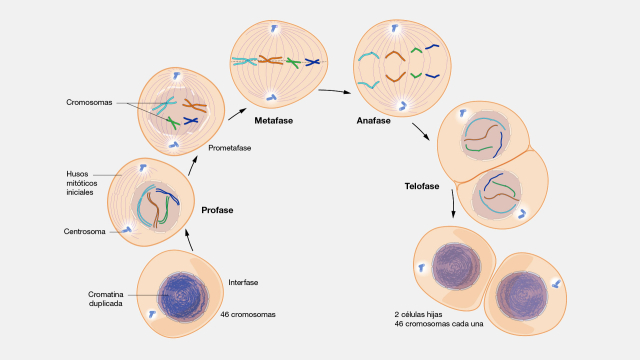Mitosis is a crucial process in the life of eukaryotic organisms, allowing cell division that results in two daughter cells genetically identical to the mother cell. This process is essential for the growth, development and repair of tissues. The phases of mitosis, its biological importance and its practical applications in medicine and scientific research are detailed below.
Phases of Mitosis.
Mitosis is divided into several well-defined phases: prophase, metaphase, anaphase and telophase. Each of these phases has specific characteristics and events that ensure the correct distribution of duplicated chromosomes in the daughter cells.
Prophase.
Prophase is the first phase of mitosis. During this stage, the chromosomes condense and become visible under the light microscope. Each chromosome consists of two sister chromatids joined by a centromere. The nuclear envelope begins to disintegrate, and the centrioles move toward opposite poles of the cell, beginning the formation of the mitotic spindle.
Metaphase.
In metaphase, the chromosomes align their centromeres in the equatorial plane of the cell, known as the metaphase plate. This alignment is crucial to ensure that, during separation, each daughter cell receives an exact copy of each chromosome. The microtubules of the mitotic spindle attach to the kinetochores of the chromosomes, preparing them for the next phase.
Anaphase.
During anaphase, sister chromatids separate and are pulled to opposite poles of the cell by the microtubules of the mitotic spindle. This separation ensures that each new cell will receive a complete copy of the original genetic material. Anaphase is a rapid but critical phase for the fidelity of cell division.
Telophase.
Telophase is the final phase of mitosis. Here, the chromosomes reach opposite poles of the cell and begin to decondense, becoming less visible. The nuclear envelope is reconstituted around each set of chromosomes, forming two daughter nuclei. At the same time, the mitotic spindle disintegrates.
Cytokinesis.
Mitosis is completed with cytokinesis, although this is not a phase of mitosis itself. Cytokinesis is the division of the cytoplasm that follows telophase, resulting in two independent daughter cells. In animal cells, a contractile ring of actin and myosin forms around the equator of the cell, strangling it until it divides. In plant cells, a cell plate forms along the midline of the cell, eventually developing into a new cell wall that separates the two daughter cells.
Biological Importance of Mitosis.
Mitosis is fundamental for several essential biological processes:
Growth and Development: During embryonic development, mitosis allows a single fertilized cell to divide and become a complex multicellular organism. This process continues throughout the life of the organism, contributing to the growth and formation of new tissues.
Tissue Repair and Maintenance: Mitosis is vital for the repair of damaged tissues. Cells in damaged tissues divide mitotically to replace dead or damaged cells. This is evident in wound healing, where mitosis allows the regeneration of skin and other tissues.
Asexual Reproduction: In many unicellular and some multicellular organisms, mitosis is the main method of asexual reproduction. Cells divide to produce genetically identical offspring, allowing rapid propagation of the species under favorable conditions.
Practical Applications of Mitosis.
Understanding mitosis has multiple practical applications, especially in the field of medicine and biotechnology.
Cancer Treatments.
Cancer is characterized by uncontrolled and deregulated cell division. Cancer treatments, such as chemotherapy and radiation therapy, often focus on interfering with mitosis. Chemotherapeutic drugs can inhibit the formation of the mitotic spindle or damage the DNA so that the cancer cell cannot complete mitosis, causing it to die. Radiation therapy can also cause damage to the DNA of cancer cells, preventing them from dividing.
Regenerative Therapies.
Mitosis is essential for regenerative and tissue engineering therapies. Stem cells, which have the ability to divide mitotically and differentiate into various cell types, are used to regenerate damaged tissues and organs. This approach has great potential in the treatment of degenerative diseases and serious injuries.
Scientific investigation.
Mitosis is an area of intense scientific research. Understanding the precise mechanisms of mitosis may reveal new ways to treat diseases and develop new biological technologies. Researchers use cell models and model organisms, such as yeast and the worm C. elegans, to study mitosis at the molecular and genetic level.
Mitosis is an essential cellular process that ensures the precise distribution of genetic material during cell division. Through its well-orchestrated phases, it allows the growth, development, repair and reproduction of eukaryotic organisms. In addition to its biological importance, the study of mitosis has significant practical applications in medicine, biotechnology, and scientific research. Understanding mitosis not only deepens our knowledge of cellular life, but also provides the foundation for innovations in treating disease and improving human health.
